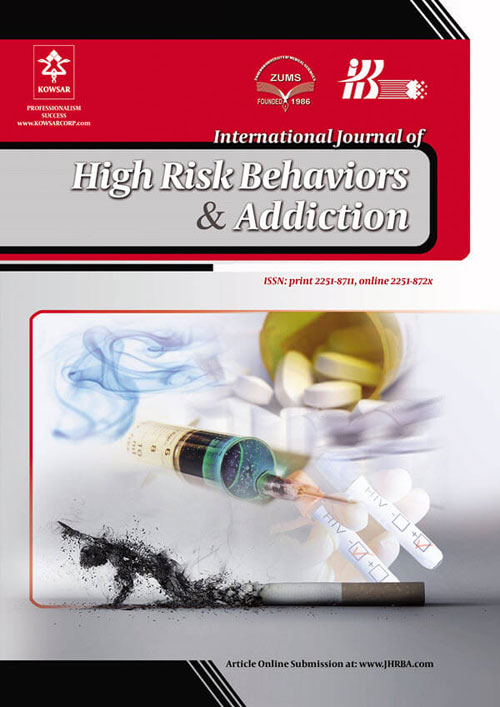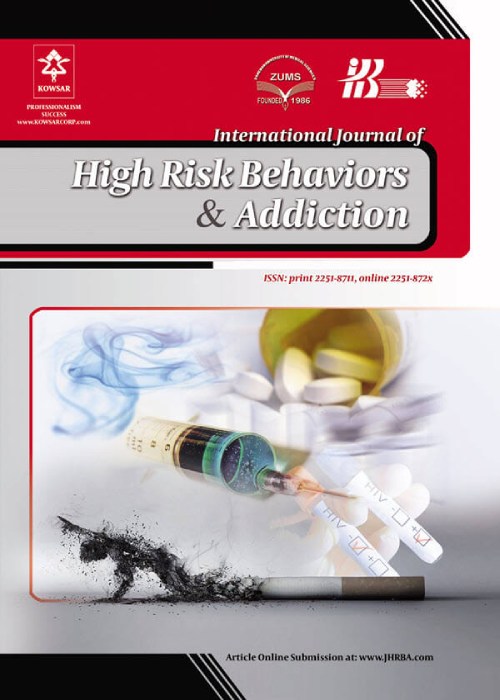فهرست مطالب

International Journal of High Risk Behaviors and Addiction
Volume:11 Issue: 2, Jun 2022
- تاریخ انتشار: 1401/04/22
- تعداد عناوین: 7
-
-
Page 1Context
The first 1000 days of life last from the beginning of pregnancy to the age of two, a unique step that shapes the basis for a person’s health over their lifetime. Numerous studies have indicated the relationship between one’s first 1000 days of life and the consequent adverse outcomes in adulthood. However, to the extent that we have reviewed it, not a single study has shown the relationship between various aspects of an individual’s first 1000 days of life and the probability of drug consumption in adult life. Hence, the primary purpose of this narrative review was to understand the role of the first 1000 days of life on vulnerability to drug abuse later in life.
MethodsThis article is a narrative review that has identified the role of the first 1000 days of life on susceptibility to substance abuse later in life. The articles were extracted from valid databases, including PubMed, Scopus, Science Direct, Web of Science, and Embase.
ResultsVarious significant research has pointed to the mother’s distress and anxiety during pregnancy through embryonic planning, influencing the planning of the hypothalamic-pituitary-adrenal (HPA) axis and epigenetic changes. The intestinal microbiota is a part of a complex link named the microbiota-gut-brain axis that can affect drug abuse through the variety and number of intestinal microbiota. On the other hand, a mother’s drug consumption during pregnancy can function as chronic stress by affecting the enteric nervous system (ENS), which activates the concurrent axis of HPA and dopamine pathways by changing the reward circuit and the subsequent increase in drug abuse. The results indicated that various factors, such as exposure to adverse childhood experiences (ACEs), parental separation, and attachment insecurity, increase the probability of drug abuse in adulthood. Nevertheless, the quality of nurturing care during the first 1000 days of life and the mother’s warm relationship with children may hinder the increase in addiction in society.
ConclusionsThe first 1000 days of one’s life are a crucial and delicate stage. If these days are tainted with unpleasant events, the various mechanisms can reduce a person’s resilience to drug abuse in later life. How the first 1000 days of an infant’s life and the quality of this period, such as prenatal stress, substance use during pregnancy, ACEs, maternal-infant bonding, maternal separation (MS), and intestinal microbiota, can affect drug abuse in the future. As a result, focusing on the first 1000 days of life is critical to adapting prevention strategies. Health policymakers can design suitable entries during pregnancy and early childhood to reduce the probability of drug abuse.
Keywords: The First 1000 Days, Drug Abuse, Adverse Childhood Experiences, Maternal Bonding, Environmental Enrichment, Maternal Separation -
Page 2Background
Adolescence is one of the most important and challenging stages in life. psychological, cognitive and emotional changes during this period can expose adolescents to high risk behaviors.
ObjectivesThe current study examined the effectiveness of resilience training on emotional intelligence (EI) and assessed gender differences in this regard among adolescents living in the outskirts of Shiraz, Iran.
MethodsThis pre-post study included 191 students and used an intervention consisting of nine resilience-training sessions. The evaluated outcomes were EI and its 15 components. The paired-samples and independent-samples t-tests were used to analyze the data.
ResultsOut of 191 students, 88 (46.1%) were boys. Before and after the intervention, the mean EI score for boys was 312.52 ± 37.79 and 327.31 ± 37.75, while for girls, it was 310.74 ± 30.05 and 312.20 ± 29.51, respectively. Following the intervention, the scores of boys in problem-solving (P = 0.007), happiness (P = 0.001), emotional self-awareness (P = 0.044), optimism (P = 0.029), self-regard (P = 0.046), impulse control (P = 0.013), and social responsibility (P = 0.042), as well as the total score of EI (P = 0.005), increased significantly. However, only the optimism score (P = 0.004) rose significantly in girls post-intervention. In addition, there were significant differences in the mean of problem-solving (P = 0.006), happiness (P = 0.001), impulse control (P = 0.042), and the total score (P = 0.035) between boys and girls, before and after the intervention.
ConclusionsResilience training may help moderate high-risk behaviors among adolescents living on the outskirts of Iran’s major cities, particularly boys. Based on the gender differences in EI components, it was suggested that female adolescents required significantly more attention. Nonetheless, gender differences in EI components were contentious, and it was concluded that a variety of factors, including the socio-cultural context, may be involved.
Keywords: Emotional Intelligence, Gender Differences, Iran, Resilience, Students -
Page 3Background
Psychological problems are common among drug users. However, a few studies have investigated the role of psychological factors, including depression, anxiety, and childhood trauma, on sexual dysfunction in MMT patients.
ObjectivesThis study aimed to determine the prevalence of sexual dysfunction and the role of psychological factors, including anxiety, depression, and childhood trauma, on the sexual function of patients on MMT. Patients and
MethodsIn this cross-sectional study, 100 MMT patients were selected by convenience sampling among patients referring to Baharan Psychiatric Hospital, Zahedan, Iran. All participants completed self-report questionnaires, including the Beck Anxiety Inventory (BAI), Beck Depression Inventory-II (BDI-II), Childhood Trauma Questionnaire (CTQ), and International Index of Erectile Function (IIEF-15). Statistical analysis was done with Pearson correlation coefficients, and stepwise linear regression models determined the predictors of sexual function.
ResultsSeventeen percent of participants reported various degrees of sexual dysfunction. Child sexual abuse and depression were significant predictors of sexual dysfunction. The regression analysis showed that 12% of the variance of sexual dysfunction (R2 = 0.12; F = 6.61; P < 0.002) was predicted by an experience of childhood sexual abuse and depression.
ConclusionsPeople on MMT suffer from psychological problems as the risk factors for sexual dysfunction. Thus, mental health care staff should consider psychological factors to prevent and treat sexual dysfunction.
Keywords: Sexual Dysfunction, Childhood Trauma, Depression, Anxiety, Methadone, Substance-Related Disorders -
Page 4Background
Squamous cell carcinoma (SCC) is the most common malignancy of the oral cavity with a highly aggressive nature. Verrucous carcinoma (VC) is a low-grade SCC with mild clinical and pathological characteristics. Extracellular matrix degradation (ECM) by several proteolytic enzymes, especially matrix metalloproteinases (MMPs), is an important factor in tumor growth, invasion, and metastasis.
ObjectivesThe aim of this study was to evaluate the expression level of immunohistochemistry of MMPs 2 and 9 in SCC and VC of oral cavity.
MethodsThe present study was conducted on the data of 20 SCC and 18 VC samples obtained from the pathology department archives. Microscopic examination was performed after immunohistochemical staining of the samples for MMP-2 and MMP-9. Data analysis was performed in SPSS 20 software. Kruskal-Wallis test was used to compare variables between groups.
ResultsAll SCC and VC samples were positive for MMP-2 and MMP-9. The mean expression level of MMP-9 was 24.41 ± 20.68 in VC and 48.27 ± 12.11 in SCC. The mean expression level of MMP-9 in SCC was higher than VC. In addition, the expression level of MMP-9 varied in different histopathological grades of SCC. Matrix metalloproteinase expression levels were different in SCC grades and was especially higher in grade III. The mean expression level of MMP-2 in VC was 35.28 ± 30.63 and in SCC was 23.50 ± 12.68. The mean expression level of MMP-2 in VC was higher than SCC.
ConclusionsOur findings showed that the expression levels of MMPs 2 and 9 in SCC and VC are higher than healthy tissue.
Keywords: Matrix Metallopeptidase 2, Matrix Metallopeptidase 9, Oral Squamous Cell Carcinoma, Verucus Carcinoma -
Page 5Background
Pregnancy can affect the prevalence of domestic violence during this period for various reasons, such as decreased sexual intercourse, misconceptions, and abnormal feelings about pregnancy.
ObjectivesThis study aimed to determine the severity and frequency of domestic violence among pregnant women in Chabahar.
Materials and MethodsThis cross-sectional study was performed on 400 pregnant women referred to health centers in Chabahar, southeast Iran. The Dispute Resolution Measures Questionnaire collected the data. The ANOVA test, t test and logistic regression was used to analyze the data. Data were entered into the computer using SPSS version 16 software.
ResultsOverall, 3.5% of women experienced very mild violence, 13.5% mild violence, and 83% moderate violence during pregnancy by their husbands. There was a significant relationship between total violence and pregnant women’s and husbands’ education (P < 0.05). Also, elementary literacy of pregnant women (OR = 4.7, P = 0.001) and husbands (OR = 6.2, P = 0.001) increased the likelihood of domestic violence among pregnant women.
ConclusionsDue to the relatively high rate of moderate domestic violence, health promotion interventions, such as educating men about various dimensions of violence and its negative impact on the family, creating a culture to strengthen the status and human values of women, and holding training sessions for married men, can help reduce violence during pregnancy.
Keywords: Physical Abuse, Psychological Violence, Sex Offenses, Pregnant Women, Violence, Intimate Partner Violence -
Page 6Background
Compulsive behaviors, loss of control, and social and occupational dysfunctions are complications of methamphetamine dependence.
ObjectivesThis study aimed to investigate the effectiveness of perphenazine on control of craving and relapse in methamphetamine users.
MethodsThis double-blind randomized controlled trial was performed in 2017 - 2018 in Isfahan, Iran. The samples included 40 methamphetamine-dependent subjects referred to drug rehab centers in Isfahan. While the intervention group received perphenazine for eight weeks, the control group received placebo tablets. Also, both groups were followed up for four months. Cocaine Craving Questionnaire-Brief (CCQ-Brief) was filled for each patient before and after the intervention.
ResultsCCQ-Brief scores were significantly lower in the intervention group compared to the control group (P < 0.0001). The changes in CCQ-Brief scores were also significant among both groups.
ConclusionsAdding perphenazine to the matrix program in the treatment of methamphetamine use disorder showed significant effect on the reduction of the craving to methamphetamine.
Keywords: Methamphetamine, Craving, Relapse, Matrix Program -
Page 7Background
One known risk factor for oral cancer is chewing smokeless tobacco, which is common in southeastern Iran. Smokeless tobacco-related oral complications can be evaluated by assessing parameters of oxidative stress.
ObjectivesThis study evaluated salivary malondialdehyde (MDA) levels in paan users and compared them with nonusers.
Patients and MethodsIn this study, saliva was collected from 50 paan users and 50 nonusers referred to the Zahedan Dental School in Zahedan, Iran. Salivary MDA was assessed based on standard biochemical methods, and the data were analyzed using a t-test and analysis of variance.
ResultsIn the paan users and the controls, the mean MDA was 2.19 ± 1.05 and 1.24 ± 0.62 (nmol/mL), respectively, and both groups showed significant differences (P < 0.001). The daily consumption and duration were significantly correlated with the MDA concentration, respectively (r = 0.722, P < 0.001), (r = 0.764, P < 0.001).
ConclusionsIn paan users, salivary MDA concentrations were higher. The concentration of salivary MDA increased with the consumption of paan in more significant quantities and for a more extended time.
Keywords: Smokeless Tobacco, Saliva, Lipid Peroxidation, Malondialdehyde


